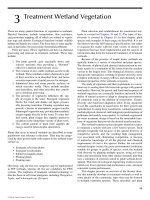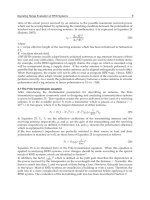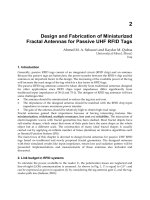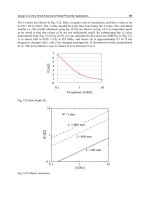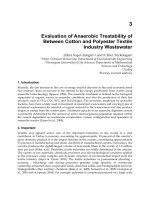Aluminium Design and Construction - Chapter 3 potx
Bạn đang xem bản rút gọn của tài liệu. Xem và tải ngay bản đầy đủ của tài liệu tại đây (318.31 KB, 19 trang )
CHAPTER 3
Fabrication
3.1 PREPARATION OF MATERIAL
3.1.1 Storage
Aluminium materials waiting to be fabricated are obviously best stored
in the dry. But if they do get wet, at least they will not rust. One
possible problem during storage is water staining, which appears as
ugly blotches varying from white to dark grey [8]. This occurs when
water is trapped between flat aluminium surfaces, and sometimes happens
as a result of condensation when metal is brought in from the cold.
Water stains have no effect on structural performance, but must be
avoided when good appearance is needed.
3.1.2 Cutting
Most of the techniques used for cutting steel are suitable for aluminium,
including shearing, sawing, notching, nibbling and routing. Sawing, in
particular, is quicker and easier than for steel, provided the appropriate
tooth size and cutting speed are used. Circular saws and band saws are
both employed.
Flame cutting is, unfortunately, no good for aluminium because of
the ragged edge produced. For profiled cuts, it is necessary to use band
sawing or plasma cutting.
3.1.3 Holing
Drilling of aluminium is faster than with steel, and is the normal method
of making holes. When punching is used, it is desirable to punch to 75%
of the final hole size and drill out. This applies especially when the diameter
is less than the thickness, leading to enlargement of the hole on the tearout
side. The practice of predrilling holes for fasteners to a smaller diameter,
and reaming after assembly, is commoner in aluminium than in steel.
Hole spacing and edge distances must not be made too small, so as
to avoid premature tearing in joints loaded in shear. British Standard
Copyright 1999 by Taylor & Francis Group. All Rights Reserved.
BS.8118 imposes the following limits, measured to hole centres: hole
spacing
у
2.5d
0
; edge distance
у
1.5d
0
, where d
0
is the nominal hole
diameter. This minimum value for edge distance is safe if applied to an
extruded edge, but with a cut edge (sawn or sheared) it may be prudent
to increase it to allow for inaccurate cutting.
3.1.4 Forming
Procedures for bending and forming aluminium are broadly similar to
those for structural steel, and the same equipment is generally suitable.
However, some aluminium materials are less readily formed than steel,
especially heat-treated alloys in the full-strength T6 condition. The formability
of non-heat-treatable material depends on the temper in which it is supplied;
it is readily bent in the softer tempers. Data on the formability of different
alloys appears in Chapter 4 (Section 4.3.4). Because of aluminium’s lower
elastic modulus (E), springback is greater than with steel.
Heat-treated material should only be manipulated when cold, and
bending it in the full-strength T6 condition is difficult. The 6xxx-series
alloys, and even worse the 2xxx alloys, will accept very limited
deformation in this condition, and such practice is forbidden for 7xxx-
series material, because of the risk of stress-corrosion cracking. Ideally,
heat-treatable material should be bent in the T4 condition soon after
solution treatment, before it has had time to age-harden. The maximum
time after quenching is about two hours, although this can be extended
to four or five days by cold storage (-6 to -10°C). A degree of deformation
is still possible if carried out later, i.e. after the metal has undergone
natural ageing and reached its T4 properties. In either case, the material
can be brought up to full T6 properties by subsequent precipitation
treatment (artificial ageing).
Such procedures are possible only if suitable heat-treatment facilities
exist. Solution treatment involves holding the part at a temperature
slightly above 500°C for 20 or 30 minutes and then quenching it in
water, which causes distortion. The temperature needed for precipitation
treatment is lower (under 180°C) and less critical, the required holding
time being several hours.
The forming of work-hardened (non-heat-treatable) material can be
facilitated by applying local heat at the bend. A problem in so doing
is the difficulty in controlling the degree of heat, because unlike steel
aluminium does not change colour when the right temperature is reached.
This can be overcome in several ways. One way is to apply a film of
soap and see when this turns black. Another method is to go on heating
until a pine stick scraped along the surface leaves a char mark. A more
accurate technique is to employ temperature-indicating crayons.
Minimum annealing temperatures are: 1xxx-series, 360°C; 3xxx-series,
400°C; 5xxx-series, 350°C.
Copyright 1999 by Taylor & Francis Group. All Rights Reserved.
3.1.5 Machining
Because of the high metal removal rate that is possible with fully-heat-
treated material in the strong alloys, a valid technique for the manufacture
of large structural components is to machine them. For the aircraft of
World War II, this was the standard way of producing spar-booms
(extending the length of a wing), these being machined out of thick
extrusions. Since then the method has been extended to the milling of
wide stiffened panels out of thick plate. Such panels, forming large parts
of a wing or fuselage, typically comprise a skin of varying thickness with
integral stiffeners, and are machined in the flat before curving. Large
computer-controlled milling machines have been developed for such
manufacture, in which 80% or more of the original plate may be removed.
Two operations must be carried out on such material before machining
begins. One is to stress-relieve it and so prevent distortion as metal is
removed. This is done by stretching, the required force in the case of
thick plates being several thousand tonnes. The other essential operation
is ultrasonic inspection, to check for the possible presence of small
inclusions in the aluminium.
It is not only in the aero-industry that machining is a valid form of
fabrication for structural components. A simple example would be the chord
section shown in Figure 3.1 to which a cross-member has to be bolted. In
design (a) an extrusion is used, with an integral flange that is machined
away over most of its length. The alternative method of welding on a local
gusset (b) would reduce the strength of the member, especially in fatigue.
3.2 MECHANICAL JOINTS
3.2.1 Bolting and screwing
Bolts in aluminium structures can be close-fitting, in reamed holes, or
clear-ance. For the latter, BS.8118 originally limited the clearance to 0.4
mm or 0.8 mm respectively, for diameters below and above 13 mm.
Figure 3.1 Alternative designs for a gusset attachment: (a) machined; (b) welded.
Copyright 1999 by Taylor & Francis Group. All Rights Reserved.
This has now been amended (1997) to 1.6 mm for all sizes, which is
more in line with other codes.
The main decision in the design of a bolted joint is the choice of bolt
material, for which there are three basic possibilities:
• aluminium bolts;
• austenitic stainless steel bolts;
• steel bolts (suitably protected).
It is penny-pinching to select a bolt material that is less corrosion-
resistant than the aluminium parts being connected. Aluminium and
stainless steel are the preferred materials in this respect.
Aluminium bolts for non-aeronautical use are usually in the stronger
kind of 6xxx-series alloy. They can be either machined from T6-condition
bar-stock, or forged and then artificially aged (T8-condition). Design
data for such bolts is included in Chapter 11 (Table 11.1). Also available
are bolts in 2xxx-series material, which are stronger, though these may
pose corrosion problems. It is recommended that the threads of aluminium
bolts be lubricated, especially if the joint is later going to be dismantled.
The best bolts for aluminium structures are in austenitic stainless
steel (300-series), as these are much stronger than aluminium ones. The
extra cost is likely to be small relative to that of the final structure.
British Standard BS.8118 permits the use of A4 or A2 stainless bolts (see
BS.6105), each of which comes in three possible grades with tensile
strengths of 500, 700 and 800 N/mm
2
respectively.
Steel bolts (non-stainless), which must have a protective coating, can
only be considered for indoor use. When exposed to the elements it is
simply a matter of time before the coating disappears and they begin
to rust. The bolts can be cadmium-plated (or equivalent), or else have
a more durable coating of zinc, as obtained by galvanizing or sherardizing.
When there is a risk of plated steel bolts getting muddled up with a
batch of stainless steel ones, they can be separated magnetically, the
stainless being non-magnetic (if of the austenitic type).
British Standard BS.8118 calls for washers to be provided under both
bolt-head and nut. With aluminium and stainless steel bolts, these would
normally be of aluminium, in a comparable alloy to the parts being
joined. However, the British Standard also allows washers of pure
aluminium.
In specifying the length of thread and the thickness of washers, it is
important to consider whether or not threads are allowed to come within
the thickness of a part, since this affects the resistance of the joint to
failure in bearing (Section 11.1.4).
The use of set-screws with aluminium components is not generally
favoured, because of the unreliability of threads in aluminium. When such
a detail cannot be avoided, best practice is tap out the hole to a larger
size, and introduce a thread insert (Figure 3.2). This is a device resembling
Copyright 1999 by Taylor & Francis Group. All Rights Reserved.
a coil-spring, made of rhomboid section stainless steel wire, which can
be screwed into the hole. It greatly increases the life of the thread if the
joint has to be unscrewed from time to time.
3.2.2 Friction-grip bolting
This type of connection is employed when maximum rigidity is needed
under shear loading. It calls for the use of special high tensile (HSFG)
steel bolts in clearance holes, these being torqued up to a high tension
so that the service loading is carried entirely by friction. The technique
is less advantageous than in steel (Section 11.2), but it still has some
application. Practice broadly follows that for steel structures.
The bolts should be of general grade (BS.4395: Part 1). HSFG bolts of
higher grade are held to be unsuitable for aluminium, and BS.8118
restricts even the general grade to use with aluminium having a proof
stress over 230 N/mm
2
.
It is important that the mating surfaces should be flat, clean, free of
defects, and also free from any substance that would reduce the
development of friction, such as paint. Preferably, the surfaces should
be grit-blasted. British Standard BS.8118 recommends a standard treatment,
and when this is used a stated design value may be taken for the slip-
factor (Section 11.2.6).
Tightening procedures are as for joints in steel, either by controlled
torque using a calibrated wrench, or else using the part-turn method.
Refer to BS.4604.
3.2.3 Riveting
In light-gauge construction, the decision whether to rivet or weld is
slanted less towards welding than it is in steel. Small aluminium rivets
are widely used in some industries, either of conventional solid form or
Figure 3.2 Thread insert.
Copyright 1999 by Taylor & Francis Group. All Rights Reserved.
else of ingenious ‘proprietary’ design. In the late 1940s, large aluminium
rivets came into use (up to 25 mm diameter), and some notable structures
were built with them. High forces were needed to close these rivets and
special squeeze-riveters were developed for the purpose. All this
disappeared with the arrival of gas-shielded arc welding in the 1950s,
combined with the fact that riveting had become a lost art generally in
the fabricating industry. But one wonders whether the rush to weld
aluminium has not been somewhat Gadarene.
Non-heat-treatable solid aluminium rivets come in 5xxx-series alloy.
For the best shear strength, they should be supplied in a work-hardened
condition (typically quarter-hard) and driven cold. To facilitate closing
(i.e. for larger rivets), they can instead be used in the annealed O-
condition, with a slight strength penalty. In this case, they can if necessary
be driven hot, the required temperature being about 350°C. Table 11.1,
based on BS.8118, covers two typical rivet materials of this kind, 5154A
and 5056A. The latter, which is the stronger, is not recommended for
tropical environments because of possible corrosion.
The alternative is to employ rivets in heat-treatable material. These
are driven cold, normally in the solution-treated T4 condition. For the
greatest ease of closing, they should be used within two hours of
quenching, or up to four or five days if held in a refrigerator (at -6 to
-10°C). Rivets of this kind would normally be in the stronger kind of
6xxx-series alloy, such as 6082, for which strength data are included in
Table 11.1. The British Standard also includes data for rivets in the T6
condition.
Aluminium rivets should always be used in reamed holes, as they
will not tolerate a bad hole in the way that hot-driven steel rivets used
to. Because they are driven cold, or at a fairly modest temperature, they
exert negligible clamping action between the plates. On the other hand,
after driving, they fill the hole well. Aluminium rivets should not be
used in situations where they have to carry tensile loading.
The above information refers to conventional solid rivets, In the
attachment of sheet metal panels much use is made of proprietary
fasteners, which are easy to use and which are suitable for blind riveting
(access to only side of the joint). Examples of these are the well-known
‘pop’ and ‘chobert’ rivets, both of tubular form. Pop-rivets come in
diameters up to about 5 mm. They can exert a limited clamping action,
provided care is taken with plate fit-up during closing, but they do not
fill the hole so well as a cold-driven solid rivet. In contrast, the chobert
rivet, which is available in larger sizes, fills the hole well but has negligible
clamping action. A wide range of other proprietary fasteners is available,
generally more expensive, mostly for use in the aero-industry. In the
USA such fasteners, which are a cross between a bolt and a rivet, are
also popular in non-aeronautical construction.
Copyright 1999 by Taylor & Francis Group. All Rights Reserved.
3.3 ARC WELDING
3.3.1 Use of arc welding
Over the last 25 years, arc welding has achieved complete acceptance
as a method for joining aluminium, following the American development
of gas-shielded welding in the 1950s. These replaced ordinary stick welding,
which had proved useless for aluminium. Two gas-shielded processes
are available: MIG (Metal Inert Gas) and TIG (Tungsten Inert Gas).
MIG is the more widely employed, especially for heavier construction,
using weld geometries and preparations similar to those in structural
steel. TIG is employed for small welds in light gauge material, and also
for making repairs to MIG welds.
The essential feature in both processes is a flow of inert gas from the
welding torch, which shields the arc and weld-pool from the air and so
prevents oxidation. The standard gas for aluminium is argon. An
alternative possibility is helium, although this has limited application
today. For outdoor welding, it is necessary to provide a booth, to stop
the gas blowing away in the wind.
Gas-shielded arc welding can be used with most kinds of aluminium,
including 1xxx, 3xxx, 5xxx and 6xxx-seri.es materials. It is no good for
the 2xxx alloys because of cracking, nor for the stronger kind of 7xxx
material. The weaker 7xxx-series alloys are weldable, but with satisfactory
results depending critically on good technique.
Welded joints in aluminium, unlike structural steel, tend to suffer
serious weakening in the heat affected zone (HAZ) surrounding the
weld, known as HAZ softening (see Chapter 6). The strength in this
zone can be nearly halved, as for example with fully-heat-treated 6xxx
material (T6 condition), and the weakening may easily extend 25 mm
or more out from the weld. With the 7xxx-series alloys, the weakening
is less severe, but extends further. When tested to destruction, aluminium
joints sometimes fail in the weld metal and sometimes in the HAZ,
depending on the combination of parent and filler alloys being used.
In making large multi-pass welds, the fabricator should exercize thermal
control, to prevent excessive build-up of heat and consequent enlargement
of the softened zone. This is achieved by monitoring the interpass
temperature (Section 6.2). Despite the need to limit the extent of the
HAZ, it is sometimes desirable to apply preheat. Typically this would
be used when welding thin to thick, in order to achieve proper side-
wall fusion.
3.3.2 MIG welding
MIG is a direct current (DC) process with electrode positive. It is
similar to CO
2
welding of steel. The electrode is in the form of wire,
Copyright 1999 by Taylor & Francis Group. All Rights Reserved.
supplied in a coil and of typical diameter about 1.5 mm. It is fed
automatically through the torch and into the arc while the weld is
being made. The torch, which is water-cooled, is much more complicated
than that used for ordinary stick welding, since the supply tube has
to convey four things simultaneously: current, wire, argon and water.
The MIG process is suitable for welds in material down to a minimum
thickness of 4 or 5 mm.
Normally the electrode wire is pushed down the tube leading to the
torch. This can occasionally cause problems with the wire kinking and
jamming in the tube. The equipment for making the smallest MIG welds,
using 0.8 mm wire, avoids this problem by pulling the wire through the
tube. This adds further to the complexity of the torch.
The MIG process has two special attributes. First, it is suitable for
posi-tional welding, including overhead. Second, the arc-length is self-
adjust-ing. In other words, when the welder accidentally moves the
torch nearer or further away from the job, the burn-off rate momentarily
changes until the right amount of wire is sticking out again, thus
maintaining the correct arc-length automatically. This ‘semi-automatic’
feature makes it a relatively easy process to use.
When welding in the downhand position, the section area of the
maximum possible size of MIG deposit is some 40 mm
2
per pass. Much
higher welding speeds are possible than with stick welding of steel. For
a weld on 6 mm plate, a speed of 1.5 m/s would be reasonable, compared
with, say, 0.5 m/s on steel.
3.3.3 TIG welding
TIG is an alternating current (AC) process. The water-cooled torch has
a non-consumable tungsten electrode, and as with MIG it delivers a
flow of argon. The filler wire is held in the other hand and fed in
separately. TIG requires more skill than MIG, both to control the arc
length and to feed in the filler. One disadvantage is that the operator
may inadvertently let the torch dwell in one position, causing a local
build-up of heat and hence an enlarged HAZ.
The TIG process is suitable for the welding of sheet thicknesses,
rather than plate. At the top end of its thickness range (say 6 mm), the
penetration can be improved by using a helium shield instead of argon.
It is possible to adapt the TIG process to autogenous welding, i.e.
dispense with the use of filler wire. The necessary filler metal is provided
by ribs on the parts being joined, which melt into the pool. Such a
technique enables TIG to be set up for automatic welding, with machine-
controlled traversing of the torch.
A useful variant of TIG is the pulsed-arc process. This employs a DC
supply with current modulation, causing the weld to be produced as a
series of nuggets, which fuse together if the parameters are suitably
Copyright 1999 by Taylor & Francis Group. All Rights Reserved.
adjusted. The technique is claimed to be superior to ordinary TIG when
welding thin sheet, where it provides easier control of penetration. Also
there is reduced build-up of heat.
3.3.4 Filler metal
Specification of the electrode/filler wire for MIG or TIG is a design decision
and should not be left to the fabricator. It is mainly a function of the alloy
of the parts being joined, known as the ‘parent metal’. Sometimes there
is a choice between more than one possible filler alloy, and the selection
then depends on which of the following factors is the most important:
weld metal strength; corrosion resistance; or crack prevention.
We divide possible filler alloys into four types, numbered to correspond
with the alloy series to which they belong:
Type 1 pure aluminium
Type 3 Al-Mn
Type 4 Al-Si
Type 5 Al-Mg
Table 3.1 (based on BS.8118) indicates the appropriate filler type to select,
depending on the parent alloy. Compositions of actual filler alloys within
each type are given in Chapter 4 (Table 4.8). When the parts to be connected
are of differing alloy type, the choice of filler may be arrived at with the
aid of Table 3.2, which is again based on the British Standard.
Type 1 fillers
The purity of the filler wire should match that of the parent metal.
Table 3.1 Selection of filler wire type for MIG and TIG welding
Copyright 1999 by Taylor & Francis Group. All Rights Reserved.
Type 4 fillers
The advantage of these, when used for welding 1xxx, 3xxx or 6xxx-series
material, is their ability to prevent cracking. The normally preferred version
is 4043A ( 5% Si). When crack control is paramount, as in a highly restrained
joint, the 4047A ( 12% Si) filler may be specified instead, but with some
loss in corrosion resistance. Type 4 fillers provide no protection against
cracking when employed for welding parent metal containing over 2%
Mg, and are therefore unsuitable for use with most 5xxx and 7xxx materials.
Type 5 fillers
When a joint is to be made in 7xxx-series alloy or the strongest form of
5xxx (such as 5083), and the prime requirement is weld-metal strength,
the best filler alloy is 5556A (or equivalent). For other 5xxx-series parent
alloys, the precise choice of filler tends to be less critical. As a general
rule, the filler composition should broadly match that of the parent
metal. A lower amount of magnesium will produce a weaker weld,
whereas a more highly alloyed filler may lead to trouble in potentially
corrosive environments.
3.3.5 Weld inspection
The required amount of inspection at a welded joint depends on the
level of weld quality that the designer wants to achieve, and BS.8118
recognizes three such levels [9].
1. Minimum quality. This is acceptable when the force transmitted by
the joint under factored loading is not more than one-third of its
factored static resistance, and fatigue is not a factor.
2. Normal quality is called for in non-fatigue situations when the transmitted
force is too high for minimum quality to be allowed, or under fatigue
conditions when the required fatigue class is 20 or below.
3. Fatigue quality applies when fatigue is a factor in the design of the
joint, and the required fatigue class is 24 or over.
Table 3.2 Filler wire types for welding dissimilar parent alloys
Copyright 1999 by Taylor & Francis Group. All Rights Reserved.
For welds of minimum or fatigue quality, the designer must indicate
the quality level on the drawing. Where no such information is given, the
fabricator assumes that normal quality applies. For fatigue quality joints
the drawing should include the Fat-number and also an arrow showing
the direction of the fluctuating stress. As explained in Section 12.7, the
Fat-number defines the required fatigue class (24, 29, 35, 42 or 50), which
may be less than the highest class possible for the detail concerned.
The following is a summary of the main types of inspection method
that are available for aluminium welds:
1. Visual inspection before welding (surface condition, preparation,
alignment, fit-up, etc);
2. Visual inspection after welding (weld geometry, profile discon-tinuities,
alignment, etc);
3. Non-destructive testing (NDT), which aims at checking all surface
and sub-surface defects (cracks, porosity, inclusions etc):
• dye penetrant testing;
• ultrasonic testing;
• radiography.
4. Taking macro-sections from separate test-pieces, which are welded
at the same time and properly represent the technique and conditions
in the production joint.
British Standard BS.8118 provides comprehensive tables stating which
inspection methods are needed when, and also the recommended
acceptance levels for different kinds of defect. The amount of inspection
called for depends on the required quality level, the type and orientation
of the weld, and the Fat-number (when relevant). Minimum quality
welds only have to be visually inspected. Dye penetrant tests are generally
required for normal or fatigue quality, with ultrasonics or radiography
being necessary as well at transversely loaded butts. Macros are required
only for fatigue-quality welds of higher Fat-number.
3.4 FRICTION-STIR WELDING
3.4.1 The process
The friction-stir (FS) process is a solid-phase welding process, invented
in 1991 at the TWI (formerly The Welding Institute), near Cambridge,
UK. [10]. It has been developed in the first place for welding aluminium,
where it is set to become an accepted technique along with MIG and
TIG, and at the time of writing it is being exploited commercially in
several countries [11]. Possible extension of the FS process to steel poses a
Copyright 1999 by Taylor & Francis Group. All Rights Reserved.
problem, because of the need for a tool material able to withstand the
much higher welding temperature.
Figure 3.3 shows how FS works. The plates to be joined are butted
together on top of a firm support bar, and are clamped so as not to
move apart during welding. The process employs a steel welding tool
comprising a pin and a shoulder, in which the height of the pin is made
slightly less than the plate thickness. The rotating tool is plunged into
the aluminium plates until the shoulder meets the top surface, and is
then traversed along the line of the weld. Frictional heating under the
shoulder causes a zone of aluminium to become plastic. Violent ‘mashing’
and ‘stirring’ occurs in this zone and the plates weld together, by a
mechanism not unlike the formation of seam-welds in hollow extrusions.
A joint made by FS welding is flat on both sides, with a characteristic
scratch pattern on the top surface as depicted in Figure 3.4 (‘onion-ring’
structure). The figure also shows the typical cross-section of the ‘nugget’
of heavily worked material, comprising a ‘shear zone’ and a ‘flow zone’.
The process has been successfully used for welding plates from 3 to 12
mm thick. The welding tool is in hard heat-resisting steel, with a typical
Figure 3.4 Friction-stir welding: typical scratch marks on top surface and shape of ‘nugget’.
Figure 3.3 Friction-stir welding: the process.
Copyright 1999 by Taylor & Francis Group. All Rights Reserved.
shoulder diameter in the range 10–20 mm. The Norwegian firm Hydro
Aluminium a.s. has patented a modified form of tool in which the pin
has two circumferential ribs and the shoulder is slightly dished.
The force exerted on the plates by the shoulder is an important
parameter which must be monitored and controlled during welding.
The other welding parameters are shoulder diameter, tool rpm and tool
traverse speed. Figure 3.5 indicates some of the joint geometries that
can be accommodated.
3.4.2 Features of FS welding
FS welding provides a simple means of making butt-joints, for which
it has the following advantages over MIG and TIG.
• Profile. An FS joint, with its flat surfaces, has a tidier geometry than
an arc-welded joint.
• Strength. From data so far available, it appears that FS joints are
stronger than arc-welded ones. The mechanical properties in the nugget
have been found to be superior to those in the HAZ at an arc weld;
also the question of weld-metal strength (i.e. the deposit) does not
arise, because there is none.
• Fatigue. Clearly FS joints are superior in fatigue, because of their good
profile.
• Grain size. The nugget in FS welds has a finer grain size than that of the
parent metal, causing them to perform well in transverse bend tests.
• Quality control. Once the welding parameters have been established,
an FS weld is less operator dependent.
• Weldable alloys. The FS process is suitable for welding all the main alloy
types, including the 2xxx-series, and the strong kind of 7xxx (such as
7075).
• Equipment for the FS process is relatively unsophisticated.
• Power consumption is less.
• Weld-preparation. The plates are simply butted, without any
preparation.
3.4.3 Limitations
The chief disadvantage of the FS process is the need to provide a rigid
support system, to react against the considerable downward force exerted
Figure 3.5 Friction-stir welding: some joint geometries.
Copyright 1999 by Taylor & Francis Group. All Rights Reserved.
by the welding tool. This calls for the design of special FS welding
machines, either with the job moving past a fixed welding head, or else
with the job stationary and the welding head moving, the latter
arrangement being necessary for making very long welds. (Early
experiments made use of a suitably modified milling machine, the travel
on which limited the possible length of weld.)
Another snag is that a hole remains at the end of each weld run,
formed when the tool is withdrawn. This has to be filled in somehow,
an available method being friction taper plug welding. As with arc welds,
run-on and run-off plates are generally necessary, unless it is possible
to cut off the end material.
3.4.4 Applications
A major role for the FS process is likely to be in the manufacture of
large areas of stiffened plating, by welding together long lengths of
extruded planking. Such a product is attractive in truck bodies, ships,
offshore modules and bridges. The equipment can also be installed in
extrusion plants, where it provides an economic means of supplying
wide sections by welding together narrower ones, thus avoiding the
high capital cost of a very large press. Such a technique can be employed
for making double-skin stiffened plating, by welding together plank sections
of rectangular hollow profile, using an FS weld on either surface.
3.5 OTHER WELDING PROCESSES
Resistance welds are readily made in aluminium, generally with a higher
energy input than with steel. Spot welding of car bodies is standard,
latterly in conjunction with adhesive bonding. But flash-butt welding
of window frames has entirely given way to mechanical joints. Other
forms of friction welding (beside friction-stir) are also available.
3.6 ADHESIVE BONDING
3.6.1 Use of bonding
As a connection technique for aluminium, adhesive bonding has features
that often make it a valid alternative to bolting, riveting or welding
(Section 11.4.1). But its successful use is critically dependent on good
practice by the fabricator, especially as regards preparation of the surfaces.
Adhesives used with aluminium are usually epoxy materials, two
main types being available: the two-component and the one-component.
None are covered by official standards in the way that metal products
Copyright 1999 by Taylor & Francis Group. All Rights Reserved.
are, and the designer/fabricator must rely closely on information provided
by the adhesive maker. Tables 11.7 and 11.8 in Chapter 11 provide data
on selected adhesives supplied by one particular manufacturer (Ciba).
3.6.2 Surface preparation
The success of a bonded joint stands or falls on the care with which the
mating surfaces are prepared. Possible levels of such preparation in
increasing order of efficacy (and cost) are:
1. degrease only;
2. degrease, abrade and remove loose particles;
3. degrease and pretreat.
The appropriate level must be specified by the designer. The object of
using level (2), or best of all (3), instead of (1), is to make the joint more
reliable and durable in humid environments.
(a) Degreasing
The prime requirement in preparing surfaces for bonding is to remove
all traces of oil and grease, even though the surfaces may appear clean.
The following are acceptable degreasing methods.
• Vapour degreasing. The parts are suspended in the vapour of a halocarbon
solvent, such as trichloroethylene (‘trike’). This calls for a special
vapour degreasing unit.
• Immersion degreasing. The parts are successively immersed in two
tanks of the same solvent in liquid form, the first tank acting as a
wash and the second as a rinse.
• Wiping. The surfaces are degreased using a clean brush or cloth soaked
in halocarbon or other degreasing solvent.
• Detergent degreasing. The surfaces are scrubbed in a solution of liquid
detergent, and then washed with clean hot water, followed by drying
in air.
A simple test to find whether a part has been properly degreased is to see
if distilled water wets the surface and spreads, rather than forms droplets.
(b) Abrading
Light abrasion of the surfaces after degreasing gives a better key to the
adhesive. The preferred method is to grit blast, after which all loose
particles must be removed, using a clean soft brush or compressed air.
Another way to remove loose bits is to repeat the degrease operation.
If grit-blast equipment is unavailable, or the part is too thin, abrasion
can be carried out using a wire brush, abrasive cloth or a water-proof
Copyright 1999 by Taylor & Francis Group. All Rights Reserved.
abrasive paper. With these, the subsequent removal of contaminants
and dust is facilitated by the use of water, followed by drying (in air).
(c) Pretreatment
Following the degrease a recommended procedure, better than abrading,
is to etch the surfaces in a solution of sulphuric acid and sodium
dichromate. This must be followed by washing in water and drying in
air. Another possible procedure is anodizing (Section 3.7.3), after which
no further treatment is needed. Note, however, that a hard-anodized
surface is not recommended as a pretreatment for bonding.
3.6.3 Two-component adhesives
These are supplied with the resin and hardener in separate containers.
Curing begins as soon as they have been mixed, i.e. just before making
the joint. There are then two possibilities. Either the joint can be held
at room temperature, in which case it will take some hours or possibly
a day to cure (‘go off’) and develop its strength. Alternatively it can be
cured under heat, enabling full strength to be attained much more quickly.
The two-component adhesives are used when the assembled parts
can be safely left for some time before handling, while curing takes
place, or when the parts cannot be heated for some reason.
3.6.4 One-component adhesives
With the one-component adhesives, the resin and hardener come ready
mixed in a single container, chemical reaction between the two being
inhibited as long as they stay at room temperature. After application of
the adhesive, the joint is cured by heating the assembled component in
an oven. The heating cycle can typically range from one hour at 120°C
to 10 minutes at 180°C.
The one-component adhesives tend to be stronger than the two-
component. They are selected when the bonding/curing cycle has to be
reasonably quick, to fit into the overall production schedule.
3.6.5 Applying the adhesive
After the surfaces have been prepared, it is essential to prevent any
subsequent contamination, even touching with a finger. The adhesive
should be applied as soon as is reasonably possible, but not before the
surfaces have had time to dry. It need only be applied to one surface.
The adhesives come in a range of different pack types and sizes. A
convenient method is to use special cartridges that can be loaded into
a dispensing gun. The gun for two-component adhesives accepts a double
Copyright 1999 by Taylor & Francis Group. All Rights Reserved.
cartridge, and mixing takes place automatically in the correct ratio as
the gun is operated, by means of a special nozzle. On some jobs, it may
be more convenient to employ a spatula, for both mixing and application.
After use, equipment should be cleaned with hot water and soap before
residues have had time to cure and harden.
3.6.6 Clamping
It is obviously important to prevent any relative movement of the parts
until an adequate degree of curing has taken place, the time involved
being a function of the adhesive used (Section 11.4.10). The necessary
clamping can often be simplified by suitable design, as for example by
using a tongue-and-groove detail between mating extrusions. The
clamping technique may be important in controlling the glue-line thickness.
3.6.7 Curing
Two-component adhesives can be satisfactorily cured at room temperature,
although this tends to be slow. For a faster cure, the assembly may be
warmed, typically in the range 40–80°C, and this has the added advantage
of increasing the strength. A radiant heater, electric blanket or hot-air
blower may be employed for the warming, which can be controlled
with the use of temperature-sensitive paper. Refer to Figure 11.17 for
the variation of cure time with temperature for six selected adhesives.
One-component adhesives are cured by heating the assembled job in
an oven, the necessary time being a function of the temperature, which
typically lies in the range 120 to 180°C.
3.7 PROTECTION AND FINISHING
3.7.1 General description
The reason for specifying a surface finish on aluminium is either protection
against corrosion, or else appearance. Possible finishes are anodizing
(Section 3.7.3) and painting (Section 3.7.4). There are two essential ways
in which aluminium can corrode, both of which are discussed in Chapter
4 (Section 4.7):
1. General corrosion of an exposed surface. In the great majority of installations,
an aluminium surface can be left unpainted, in its as-supplied mill-
finish state. Such corrosion as may occur will not threaten the structure.
Situations that demand a protective finish are defined in Section 4.7.2.
2. Corrosion due to contact with certain other materials. This may lead to
serious attack on the aluminium and early failure. Suitable precautions
are essential.
Copyright 1999 by Taylor & Francis Group. All Rights Reserved.
3.7.2 Pretreatment
Surfaces that are going to be anodized or painted should receive a suitable
pretreatment, which normally comprises three successive dips: degrease,
rinse and etch. Many extruders offer such a pretreatment service. Various
formulations are employed for the etching agent, and these have an effect
on the final appearance when a component is later anodized.
3.7.3 Anodizing
Anodizing is a process in which the thin oxide layer, always present on
an aluminium surface, is artificially increased. The effect is to improve
the corrosion resistance and also the appearance, as compared with mill
finish. The anodized surface can be natural colour (‘satin’ finish) or coloured.
Anodizing is a low-voltage high-current electrolytic process whereby
the component is immersed in an acid electrolyte (usually sulphuric),
through which direct current is passed with the aluminium as anode.
The relatively thick oxide film thus produced contains capillary pores.
The final operation is to seal these pores by placing the component in
boiling water, which produces a hard weather-resisting surface. Colour
can be introduced by immersion in a dye tank, before sealing.
The appearance of an anodized surface is affected by the alloy-group of
the aluminium, and also by the details of the pretreatment. In welded
items, the appearance of the welds will be clearly different from that of the
parent metal, if the filler wire is of different composition as it usually is.
The thickness of the oxide film on anodized components should be
specified by the designer. For indoor applications, where appearance is
all that matters, the thickness would normally lie in the range from 0.010
to 0.015 mm (some 2 to 3 times the natural value). For outdoor use,
where protection and durability of the surface are needed, the recommended
minimum is 0.025 mm, known as ‘architectural’ grade anodizing.
It is possible to use chromic acid for the electolyte, instead of the
usual sulphuric. The resultant film is less hard and its maximum possible
thickness is only 0.01 mm. But, for a given film thickness, the chromic
process provides better corrosion resistance, making it a valid alternative
for aggressive industrial environments. It is recommended for components
containing crevices that might retain electrolyte, even after rinsing, since
aluminium is not attacked by chromic acid.
Another version of the process is hard anodizing, which enables the
oxide film thickness to be increased to 0.125 mm. Such a film is dense
and hard, and relatively rough. It is normally left unsealed, but can be
waxed or treated with mineral oil. Hard anodizing is mainly specified
for its high resistance to abrasion, which compares favourably with
that of chromium plating on steel. Corrosion resistance is excellent. The
film also acts as an electric insulator.
Copyright 1999 by Taylor & Francis Group. All Rights Reserved.
3.7.4 Painting
Alloys having durability rating A or B do not normally need to be
painted, except for the sake of appearance (Section 4.7.2). A paint finish
is more likely to be called for with C and D-rated alloys, to provide
protection. A brief outline of possible paint systems is given below.
Whatever system is used, a suitable pretreatment is essential.
Mass-produced components can be painted in the factory using powder
coatings which have largely replaced solvent-based paints for such
application. Before powder coating, the pretreated items must first receive
a chemical conversion coating. They then pass through an electrostatic
field, where they are subjected to a spray of dry powdered paint material,
after which they proceed through a tunnel oven for stoving. The stoving
cycle is typically of the order of 200°C for 10 minutes. A feature of the
process is its lack of waste, since any excess sprayed powder falls to the
floor where it can be collected and re-used.
For non-factory application, aluminium can be coated in the normal
way using solvent-based paints. It is important that none of these,
especially the priming coat, should contain copper, mercury, tin, lead
or carbon-based compounds. A preferred primer is one based on zinc
chromate.
3.7.5 Contact with other materials
At joints between aluminium and most other common metals, where
moisture may be present, it is essential to take suitable precautions to
prevent bimetallic corrosion (Section 4.7.3). British Standard BS.8118
gives detailed advice on the treatment of such joints. The main essential
is to insulate the two surfaces from each other using, in order of efficacy,
a coat of priming paint, an impervious tape, or a non-conducting gasket.
The other requirement is to apply comparable treatment to bolt holes
and under bolt heads, and to protect the heads of steel bolts with
aluminium paint, or by metal spraying with aluminium.
There are occasions when aluminium needs to be protected from
non-metallic materials with which it is in contact, in the presence of
moisture. Such materials are concrete (while still ‘green’), soil, some
woods (e.g. oak) and some insulation boards. Treatment with bituminous
paint is usually efficacious in such situations.
Copyright 1999 by Taylor & Francis Group. All Rights Reserved.
